Broiler is a hybrid of domestic animals, obtained by crossing different breeds. It is distinguished by its precocity. Broilers are called not only poultry, but also other animals, for example, rabbits.
In this article we will talk about broiler chicken, namely: where to start, how to choose eggs, what and how to feed for periods of growth, how to feed, what vitamins to give, what not to feed, diseases and what to treat. Let's talk about adult broilers: housing conditions, feeding and water, diseases and how to treat.
In general, we will go through all stages of cultivation - from eggs to the sale of the finished product.
Table of contents
How to choose eggs for growing
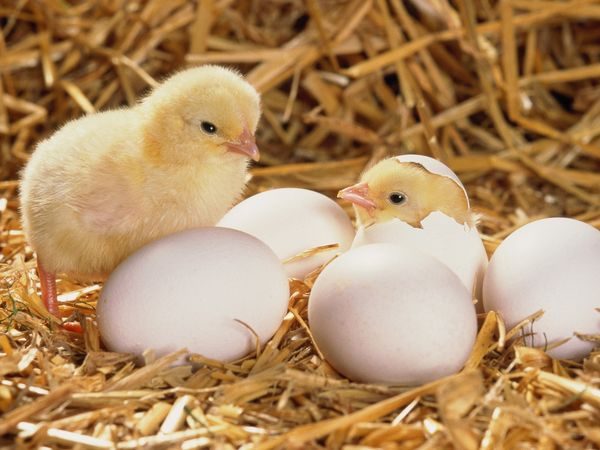
Choosing eggs for incubation is an important part of the broiler rearing process, because the percentage of chickens leaving depends on how healthy the offspring will be, how often they will get sick or not get sick at all, how quickly they will gain weight, etc. Whether you remain profitably or at a loss depends on the right choice for laying eggs.
The egg must be uniform in color. It is advisable to choose a medium size, because from small eggs the same offspring is obtained.
Large have a thin shell. Therefore, the appearance of microscopic cracks through which penetrate into the germ of infection is not excluded. In addition, chickens simply will not grow from many eggs of this size.
The weight of the egg is also chosen, if possible, the same. Then chickens are born with a slight time difference.
Eggs are taken from the nests several times a day. Do not overheat or cool them. It is advisable to store them in a warm, dry room, in which the permissible temperature drops do not exceed 5 degrees.
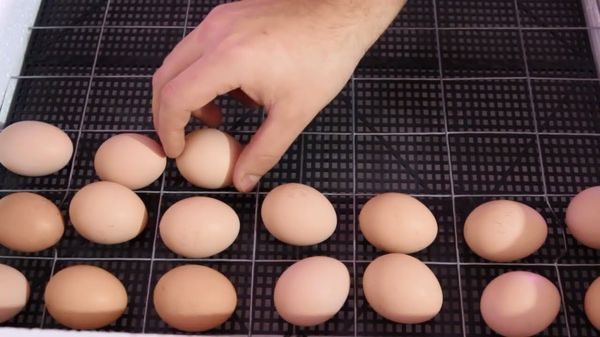
The maximum shelf life between the recess from the nest and the laying in the incubator is two or three days. If this period is exceeded, the probability of negative consequences for their healthy development in the future increases.
The correct, competent approach to the process of selecting eggs for their laying in the incubator is the key to a successful result.
The maximum age of the chicken from which eggs are taken for the incubator is limited to 2 years.
What and how to feed
Properly feeding broiler chickens, starting from the first day of their life, is very important, because starting feeding sets the appropriate growth rate and development of this poultry. In addition, the composition of the feed plays a crucial role in the quality of the final product - meat.
Broiler chickens from scratch days
There is a common opinionthat daily broiler chickens should immediately be given chopped boiled egg, cottage cheese, mixed fodders, which help strengthen the digestive system.
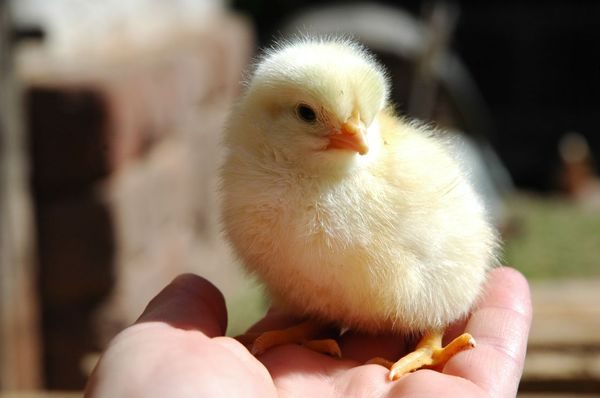
However, others caution against such a decision. They argue that this is precisely the reason for the death of the poultry population during the first 2–3 days of their lives. And feeding broiler chickens with a boiled egg at the age of 24 not only does not strengthen their immunity, but also calls for indigestion of the digestive system, causing mortality in large quantities.
It is not recommended to give any wet food. It is useful at such an early age to give only millet and a small amount of egg powder. Chicks should have free access to feed and water. The size of the cage, box, or other place in which the brood contained, allowed each chicken to eat and drink freely. In water, diluted in very low concentrations of potassium permanganate (manganese).
At the same time it is impossible to allow the change of water color to pink. It is also recommended to separately prepare an aqueous solution of glucose. This will help avoid dyspepsia - a disease of the digestive tract.
Weekly chicks
Gradually, to teach kids to start the feed you can from the fifth day of their life. Simultaneously, they are fed with a prominent solution of vitamins. Until this age, it is not recommended to give them antibiotics.
Useful in the beak of every chicken to drop "Trivitamin" - a drug for the treatment and prevention of vitamin deficiency. In the water, add "Baytril", designed to prevent infections at the rate of 1 gram per 2 liters of water.
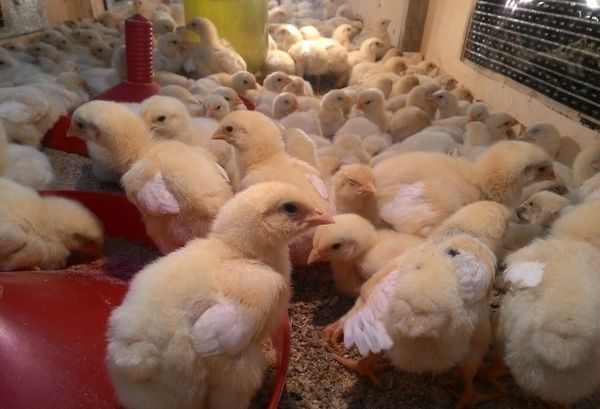
From a week old, chickens are taught to eat cottage cheese. Diet varied crushed boiled egg. Food can be slightly moistened with whey. The approximate daily rate of consumption in this period reaches 15 - 20 grams. The temperature in the room - 30 - 32 degrees.
Important! Ensure that chicks do not get dirty and wet during meals. Otherwise it is fraught with their case. In the places of their content should be dry with the desired temperature and humidity.
Chickens from 10 to 20 days
During this period, greens are added to the porridge (slightly wetted dry starter feed), for example, finely chopped onions, at the rate of 1:20. It contains the necessary vitamins. Besides, Green onions are used as an antiparasitic agent.
To avoid one of the most common diseases of poultry - coccidosis, which leads to disruption of digestion and dehydration of the body, at two weeks of age, Baikox drug is added to the water at the rate of 1 gram per 2 liters of water.
During this period, they eat food up to 30 grams per day. So that the kids have a good gain, from the first days take care of the increased light day. The ambient temperature is kept at a level not lower than 28 degrees. If youngsters at this age become supercooled, they can become ill with bronchopneumonia, which occurs just as a result of hypothermia.
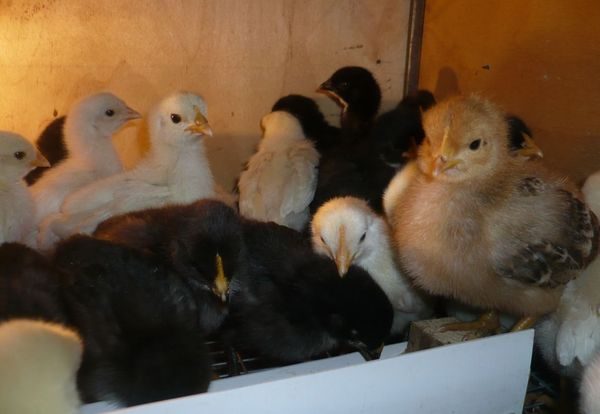
In the feed you can add the return, yogurt, buttermilk. After a 15-day feeding, protein food of plant origin is mixed into the food. The proportion of green can be gradually increased. Now it should be up to 10% of the total mass of feed.
Mix crushed eggshells, fodder yeast, grated carrots in small quantities. In no case should sand be given to chickens. Do not forget to make a very weak solution of potassium permanganate.
From 10 days for three or four days, broilers can begin to die. Therefore, during this period, we take away poultry with antibiotics. Add a few drops of iodine. After a short break, they give vitamins, vitamin D from rickets is especially important during this period.
Lack of vitamins leads to hypovitaminosis A, D, E, B. Chickens are given only high-quality food. If you buy it ready-to-pack, keep track of shelf life.
How to raise monthly chicks
After 22-25 days, they move from feeding with starter feed (croup) on growth (in granules). The composition of feed for broiler should include mineral content, protein (fish meal), cereals (corn), amino acids and vitamins. Green mass can also continue to add.
To save we advise not to buy expensive growth feed, but to make its composition by yourself: crushed wheat, oats, corn, barley, peas. All components are mixed in equal proportions. It is advisable to add in the feed fish oil, whey, meat and bone meal. Add (but not mix) the leaves of cabbage, lettuce, green onions.
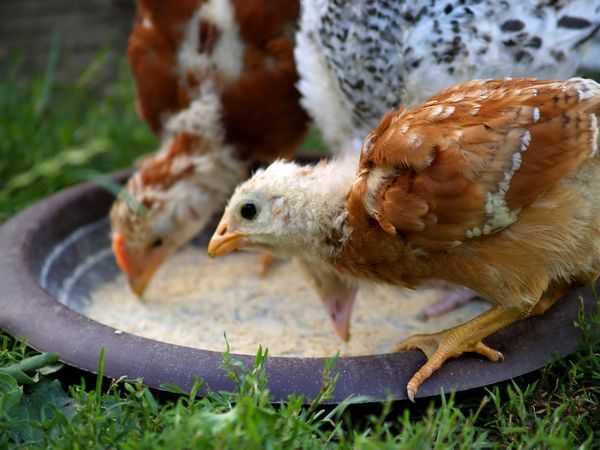
By 35 days of life, you can gradually increase the volume of corn to 40% of the total, and reduce wheat, oats and barley. Meal or cake is about 15%. The percentage of green mass can be reduced.
Under normal conditions and high-quality feeding, monthly chicks weigh about 800 grams.
We exclude from the diet all types of bread, boiled potatoes (if it is not mixed with other components), all stitched products, especially if there is a smell. We remind you to refrain from pouring sand. We make sure that the water of the chickens is constantly clean, fresh, slightly warm. It is useful to use distilled water.
The temperature of the environment is lowered to 23 - 25 degrees. The duration of lighting is reduced to 14-16 hours per day.
To avoid aspergillosis at this age, it is necessary to ventilate the room well, to avoid dampness.For the purpose of prophylaxis, add some iodine-containing preparations to feed and water.
Chickens 45-50 days
After 40 days of life, the youngsters are given not crushed, but whole grains. A purchased finishing feed containing the basic nutrients is also used. But if you want to have tasty meat, you can refuse to purchase it.
Already whole, not crushed grain is poured into the feeders. Vitamins, fodder yeast, chalk should also be present in the feed. Upon reaching the age of 45 days, exclude any medication. Cooking porridge, which includes boiled small fish, corn, wheat, peas, greens, gives a good effect.
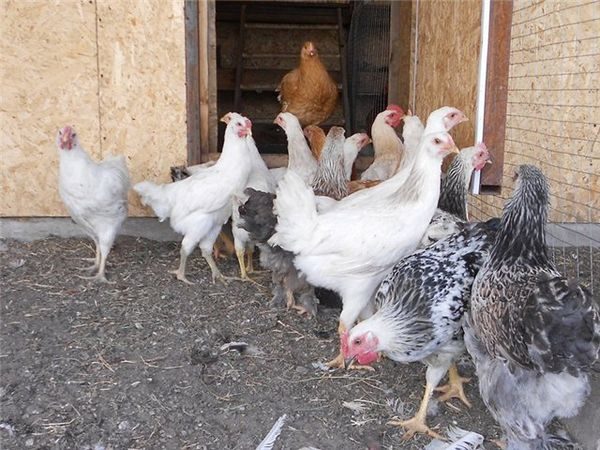
All this is stirred and allowed to infuse. In the porridge, the percentage of corn is increased to half of the total mass.
If you did not save on feed and gave a full diet, their weight at this age should be more than one kilogram. The breed also has a great influence on this indicator.
If the weight of a unit of young stock of one breed reaches 1, 2 - 1.3 kg, then the weight of an adult chicken of this age can be 1.6 - 1.8 kg. other things being equal.
We continue to use clean distilled water. The ambient temperature is gradually lowered to 21 - 23 degrees. The duration of daily illumination is reduced to 12-14 hours.
Breeding adult broilers at home
Keeping broilers for fattening for longer than two months does not have economic feasibility, because with age the bird gains weight more slowly and consumes more feed. In addition, broiler meat older than 70-75 days less tasty than two months.
Cellular maintenance and care at home
If you want to grow up to 10 heads of chicken broilers at home, their cellular content will suit you. Depending on the size of the cage, they contain 3-5 heads (then we make the size of the cage from such a calculation in order to limit the free movement of the bird to the required - go to the trough and the trough), or up to 10 heads (the size of the cage increases,requirements for spatial conditions of keeping and breeding remain the same).
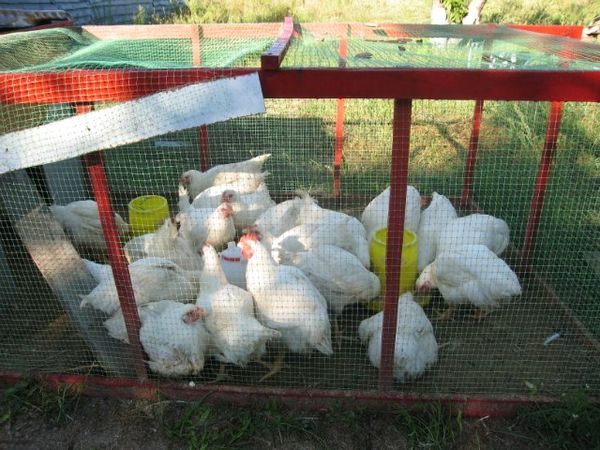
When growing livestock more than 10 units need to do or extra cells (since one cell, when it contains more than a dozen heads, is very cumbersome and inconvenient to move, loses mobility), or think about the content in the pen.
Let's say it is economically beneficial for you to breed livestock in cages. Then, for dry food (feed, grain), it is advisable to choose feed type gutter, which is placed outside the cells along the whole tier. The drinking trough also build a solid, for example, from PVC sewer pipe.
The front side of the feeder can be made of metal rods of the combined type. This is convenient in that at first chickens can be contained in such a cage.
Steel rods on the walls are located among themselves quite often, so that the brood does not run out of the cage or fall out of it (if the cage is in the second or third tier).
The field of how the youngsters grow up is planted in different cells, removing the rods from the walls through one. Thus, we provide free access for an adult broiler to feed.
How to grow: tips for beginners
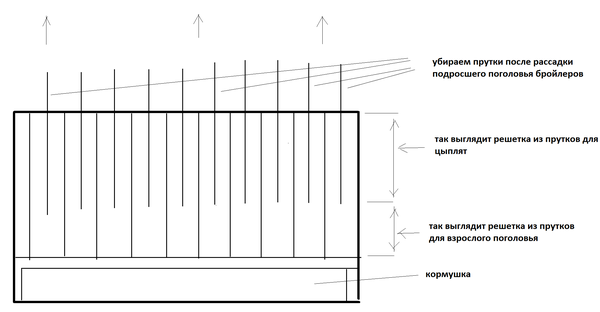
There are several requirements for the housing conditions of adult broiler birds:
- so that the area of content made it possible eat freely each individual, that is, not too small, but not excessively large (the reasons given above);
- permanent availability of high-quality fresh food in feeders. In addition, separate porridge feeders can, and should be, if used;
- constant availability of fresh (better than separated) warm water in drinking bowls, but not higher than 22-25 degrees;
- enough hours light day (12-14 hours). If less - give additional lighting;
- humidity air 68-72%;
- no dampnessespecially in cells;
- no drafts must not be;
- ambient temperature - within 20-21 degrees (if it is lower, the broiler activity decreases, the intensity of eating the food decreases, the mass build-up slows down; if it is higher, the bird gets hot, the result is the same);
- mandatory availability ventilation, because otherwise intensive accumulation of nitrogen adversely affects the life of the bird.A case is described when the owner, in order to save on heating, placed hundreds of broilers in the greenhouse, where greens were grown in a small, improvised pen. Despite the fact that the greenhouse had access to fresh air from time to time, after a few days the green began to fade due to the increased nitrogen content in the air, although this was not felt. After the paddock was fenced off with a film, the concentration of nitrogen in the environment in the pen reached such a level that the chickens began to behave sluggishly, ate reluctantly, and gained weight slowly.
- cells inside must be clean. To do this, you can make the floor of a galvanized welded mesh fine-meshed, and clean the floor tray, based on the amount of litter accumulated in it;
- if growing broilers at home is “put” on stream, then it is necessary to periodically cell disinfection (after the slaughter of the previous batch, but before growing the second).
Disadvantages of keeping birds in cages:
- requires cash investment more than with the driven way of growing.
Advantages:
- more convenient in service;
- more compact (saves used space).
How to maintain and grow a broiler in the pen
This way of keeping broiler chickens and indocores from zero days does not differ from the previous one. The main differences are as follows:
- cost effective in terms of construction. In fact, in order to raise birds in a pen, you need floor and walls. If you are going to grow a bird in a shed, then part of the shed is fenced off by folding sections of welded cellular wire, put troughs and troughs - and the pen is ready;
- designed for content not less than 10 goals birds;
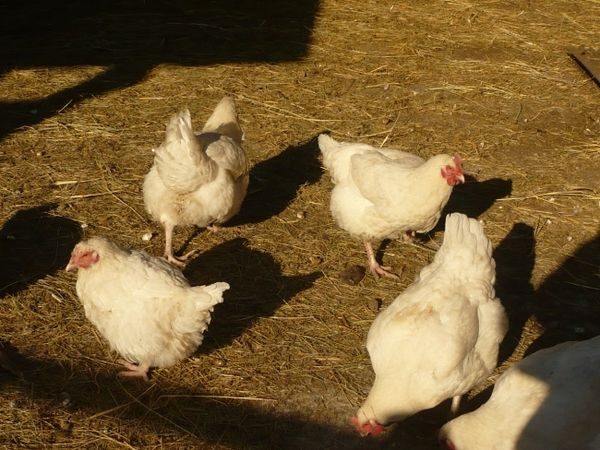
Disadvantages:
- requires increased care and attention to eliminating dampness and high humidity, you need to frequently change the litter broilers to keep the floor dry;
- on the area occupies more space based on one unit of livestock.
Advantages:
- less material costs, compared to the first method.
Requirements for ambient temperature, humidity, absence of drafts, dampness and other conditions are maintained.
Proper feeding. Where to begin
As mentioned above, it does not make sense to fatten broilers for more than two months. This is justified by the following:
- after two months fattening bird gains weight more slowly;
- consumption feed increases;
- broiler meat over 2.5 months tougherless tasty.
Feeding adult broilers (in our case, in the recommended age range from 60 to 75 days), comes down to the fact that they need to be given only high-quality food with the following diet:
But worries will increase, in order to raise chickens you will need to buy separately wheat grain, barley, maize, peas, etc., to mix it all in proportions. Do not forget to give greens, add fish meal.
If you are not too lazy, then cook for your poultry porridge from the above ingredients with the addition of cooked small fish. If there is no fish, add fish oil. The main share should be corn (up to 50%).
Some when growing poultry go after two months of fattening exclusively to corn and greens (5 - 10 days before slaughter). Under normal complex feeding, expect that your broilers will weigh at least two kilograms by 70-75 days of fattening.
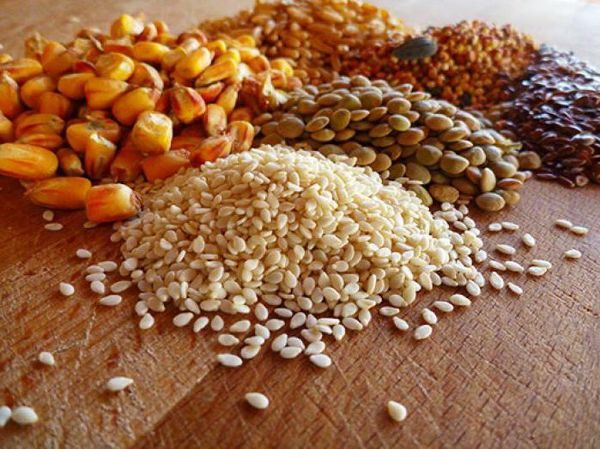
Attention! We do not give broilers:
- boiled potatoes (if it is not mixed with other components);
- all varieties of bread;
- everything overdue products;
- sand;
- medication (if possible);
- simultaneously several new products food in large quantities;
- other components, if we see that they cause negative reaction in the bird.
What to water
Follow the same rules as for the rearing of young stock. Water should be:
- cleanpreferably desiccated;
- moderately warm (around 20 - 21 degrees);
- in drinking bowls providing unhindered access birds (depending on the number of livestock);
- can be diluted in very low concentration potassium permanganate (manganese). At the same time it is impossible to allow the change of water color to pink.
Diseases of broiler chickens
Broiler chickens can suffer from quite a few diseases. Some of them:
- heterocidosis - worms in the intestines. Piperazine may be used against this disease. Preventive measures - thoroughly clean the room where the chickens are located;
- arthritis - the joints of chickens suffer (broilers walk less, try to sit down). You can use ampicillin (10 mg per 05 kg of chicken weight) for 5 consecutive days.
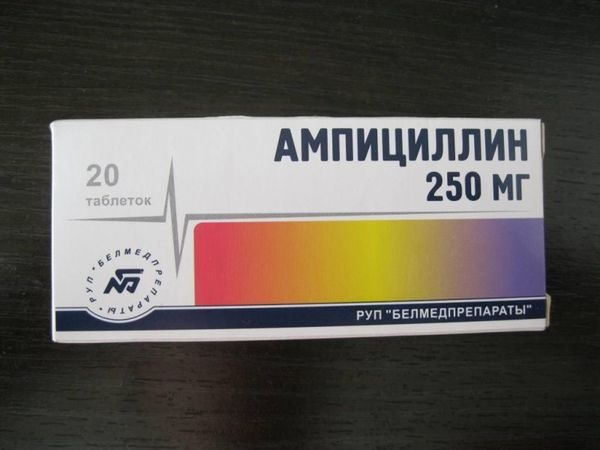
Ampicillin for arthritis Measures to prevent arthritis: give only high-quality food, litter should be dry;
- ascites (accumulates fat in the abdomen). The bird sluggishly and reluctantly walks. To avoid this disease, you must give greens;
- salmonellosis is manifested in indigestion. Can be treated with tetracycline or ditrevitom. The dosage is indicated in the instructions for these drugs;
- pseudocode - chickens can become infected through infected egg shells. It is necessary to remove the diseased and sanitize the room;
- simple poisoning. To avoid this, you need to make sure that the feed is fresh and of high quality, and foreign objects (for example, fish bones) do not get into the feeders.
If you do everything right, the result will not take long.
Recommendation for beginners: nothing is better than personal experience. Therefore, in the initial stages of development of your business, you can use the information and recommendations of others. But if in practice you achieve the best results due to your experience, it’s a sin not to use it.
If you see that some recommendation does not fit the conditions of broiler chickens in your conditions, think for yourselfhow to get out of position for optimal results.
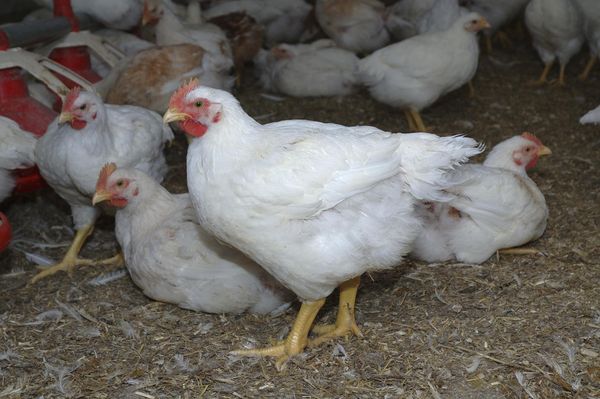
Very nice, full article. The only thing I did not understand about the pen. What size should it be for 10 chickens? How much space is needed on the 1st broiler?
I feed the chickens only with purine feed and water. More than anything. We have 40 days. Weight from 2000 to 2700. Is this normal?